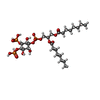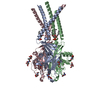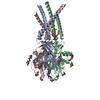+Search query
-Structure paper
| Title | Inhibition of the proton-activated chloride channel PAC by PIP. |
|---|---|
| Journal, issue, pages | Elife, Vol. 12, Year 2023 |
| Publish date | Jan 12, 2023 |
 Authors Authors | Ljubica Mihaljević / Zheng Ruan / James Osei-Owusu / Wei Lü / Zhaozhu Qiu /  |
| PubMed Abstract | Proton-activated chloride (PAC) channel is a ubiquitously expressed pH-sensing ion channel, encoded by (). PAC regulates endosomal acidification and macropinosome shrinkage by releasing chloride ...Proton-activated chloride (PAC) channel is a ubiquitously expressed pH-sensing ion channel, encoded by (). PAC regulates endosomal acidification and macropinosome shrinkage by releasing chloride from the organelle lumens. It is also found at the cell surface, where it is activated under pathological conditions related to acidosis and contributes to acid-induced cell death. However, the pharmacology of the PAC channel is poorly understood. Here, we report that phosphatidylinositol (4,5)-bisphosphate (PIP) potently inhibits PAC channel activity. We solved the cryo-electron microscopy structure of PAC with PIP at pH 4.0 and identified its putative binding site, which, surprisingly, locates on the extracellular side of the transmembrane domain (TMD). While the overall conformation resembles the previously resolved PAC structure in the desensitized state, the TMD undergoes remodeling upon PIP-binding. Structural and electrophysiological analyses suggest that PIP inhibits the PAC channel by stabilizing the channel in a desensitized-like conformation. Our findings identify PIP as a new pharmacological tool for the PAC channel and lay the foundation for future drug discovery targeting this channel. |
 External links External links |  Elife / Elife /  PubMed:36633397 / PubMed:36633397 /  PubMed Central PubMed Central |
| Methods | EM (single particle) |
| Resolution | 2.7 - 2.71 Å |
| Structure data | EMDB-28535, PDB-8eq4: EMDB-28964, PDB-8fbl: |
| Chemicals |  ChemComp-NAG:  ChemComp-PIO: |
| Source |
|
 Keywords Keywords | MEMBRANE PROTEIN / PAC / TMEM206 / ASOR / PAORAC / ion channels / chloride channel |
 Movie
Movie Controller
Controller Structure viewers
Structure viewers About Yorodumi Papers
About Yorodumi Papers







 homo sapiens (human)
homo sapiens (human)